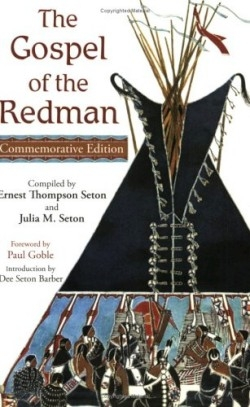The Gospel of the Redman
Commemorative Edition
This compilation of Native American traditions and beliefs offers readers a glimpse into the lifestyle of some of the twentieth century’s most prominent tribes of First Americans—and their leaders. Because of the number of different tribes present in North America, the husband-and-wife authors focus on the philosophies of only a few to show the influence of Native traditions on art, handicrafts, agriculture, and health. As the founder of both the Boy Scouts of America and the Woodcraft League, Ernest Seton (1860—1946) found his home in the great outdoors. He published prolifically throughout his life, focusing on nature and scientific topics that “solidified his reputation as a biologist.”
Featuring the author’s illustrations of tribes’ weaponry, clothing, and instruments, this comprehensive overview of Native American life is organized clearly into sub-categories for easy reading and reference. Topics range from spirituality to domesticity to conversations that Seton enjoyed with famous tribal chiefs. Photographs of Ernest as a child in England, as well as photographs of him and his wife as they traveled throughout North America, are also included. Julia Seton was an author and naturalist herself, writing about Native American arts, crafts, and music; she joined her husband as a lecturer when they presented their work throughout the United States, Canada, and Europe.
While the text offers much in the way of chronicling Native American life, the introduction (by the Setons’ daughter) acknowledges the possible misinterpretation of the title and explains the manner in which the word “Redman” is used. Further, while Ernest Seton acknowledges that he cannot write about all American Indians because of the number of tribes on the continent, he states that he includes in his text the “highest and best”—surely contested terms that demand clarification: What is highest? What is best? What qualifies this author to determine that certain tribes qualify, and not others?
These shortcomings, however significant to individual readers, speak to the fact that this text is reprinted from 1937. That is, the sensibilities of the time in which the text was written have changed significantly. However, the spirit and intention of the text during its era are positive and thorough. Overall, the authors inform their readers about the richness of the Native American way of life—all too often ignored by the dominant white culture—with a devotion to detail that celebrates the contributions of the First Americans.
Reviewed by
Carla L. Verderame
Disclosure: This article is not an endorsement, but a review. The publisher of this book provided free copies of the book to have their book reviewed by a professional reviewer. No fee was paid by the publisher for this review. Foreword Reviews only recommends books that we love. Foreword Magazine, Inc. is disclosing this in accordance with the Federal Trade Commission’s 16 CFR, Part 255.

